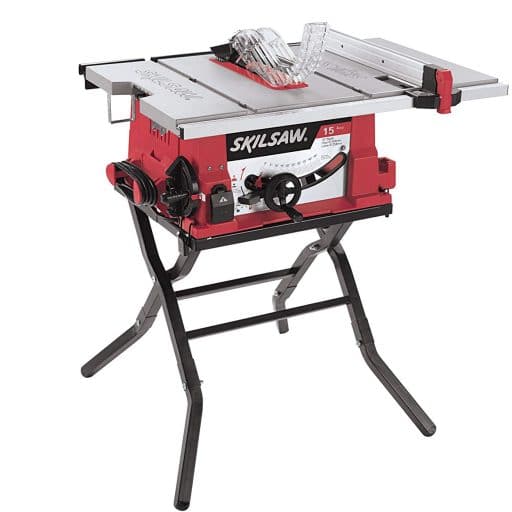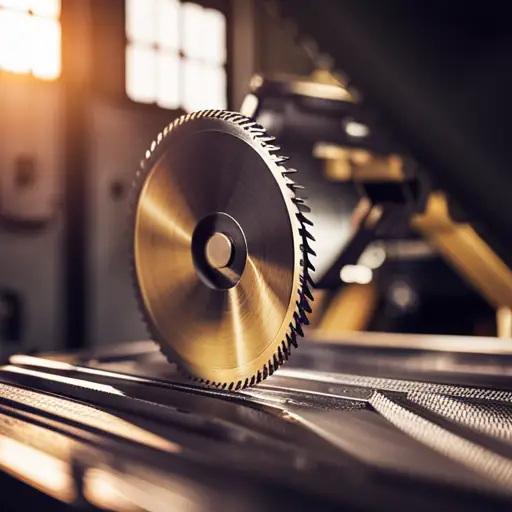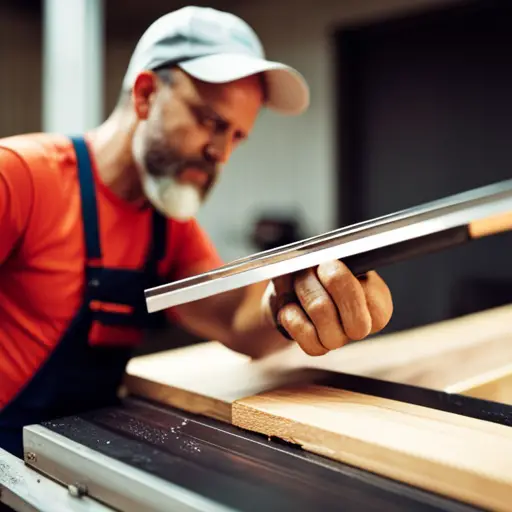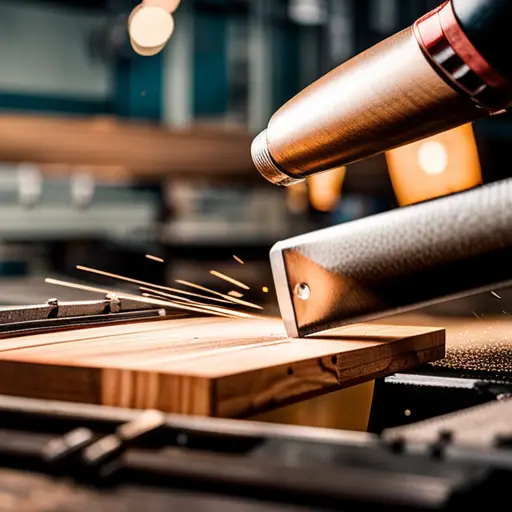When it comes to woodworking, having the right tools is essential. And one tool that stands out in its versatility and functionality is the combination table saw blade. This remarkable tool unlocks a myriad of benefits for woodworkers, making it an indispensable asset in any workshop.
Combination table saw blades are designed to excel in various woodworking projects, providing exceptional versatility that allows craftsmen to tackle different tasks with ease. From crosscutting to ripping and everything in between, these blades deliver clean and precise cuts consistently.
Not only do combination table saw blades save time by reducing the need for blade changes, but they also offer cost-effectiveness by eliminating the necessity of purchasing multiple specialized blades. With one reliable blade at hand, woodworkers can efficiently complete their projects without breaking the bank.
Furthermore, using combination table saw blades enhances woodworking skills as they require a certain level of precision and technique to yield optimal results. Woodworkers can hone their craft while achieving professional-grade outcomes.
In this article, we will explore these advantages in detail and delve into how combination table saw blades can elevate woodworking experiences. By unlocking the full potential of this versatile tool, woodworkers can take their craftsmanship to new heights.
Key Takeaways
- Combination table saw blades are versatile and functional tools for woodworking that excel in various projects.
- They save time and cost by eliminating the need for blade changes and multiple specialized blades.
- Combination blades enhance woodworking skills and allow for professional-grade outcomes.
– They deliver clean and precise cuts with minimal tear-out, ensuring smooth edges and tight-fitting joints.
Versatility for Various Woodworking Projects
The versatility of combination table saw blades allows woodworkers to seamlessly transition between projects, effortlessly cutting through both soft and hardwoods with precision and ease. These blades are designed with a combination of different tooth styles, allowing them to tackle a wide range of woodworking tasks.
By incorporating a mix of rip and crosscut teeth, these blades provide improved project outcomes by delivering clean and smooth cuts in various materials.
One key benefit of using combination table saw blades is their ability to handle both softwoods and hardwoods effectively. The rip teeth on these blades are specifically designed for cutting along the grain of the wood, making them ideal for ripping through softwoods like pine or cedar. On the other hand, the crosscut teeth are able to cut across the grain, which is necessary when working with hardwoods such as oak or maple. This versatility eliminates the need for woodworkers to switch between different blades for different types of wood, saving time and effort.
Furthermore, combination table saw blades expand creative possibilities by enabling woodworkers to experiment with different materials without limitations. Whether it’s creating intricate designs on hardwood furniture or building simple wooden structures from softwood, these blades provide consistent performance throughout various woodworking projects. Woodworkers can confidently take on new challenges knowing that their combination table saw blade will deliver precise cuts every time.
The versatility offered by combination table saw blades improves project outcomes by providing cleaner and smoother cuts in both softwoods and hardwoods. Additionally, these blades expand creative possibilities by allowing woodworkers to work with a wide range of materials without having to switch between different types of saw blades. With their ability to seamlessly transition between projects and deliver precise cuts consistently, combination table saw blades prove to be an essential tool in any woodworking workshop.
Time-Saving Capabilities
One advantage of utilizing combination blades is their ability to reduce the time required for cutting tasks, as evidenced by the adage ‘time is money.’
Combination blades are designed with specific features that contribute to improved efficiency and enhanced productivity in woodworking projects. These blades typically have a higher tooth count compared to other types of blades, allowing them to make smoother and cleaner cuts. The increased number of teeth also means that each tooth removes less material with every pass, resulting in faster cutting speeds.
Additionally, combination blades often incorporate specialized tooth configurations such as alternate top bevel (ATB) and flat top grind (FTG). The ATB teeth are angled on both sides, enabling them to slice through wood fibers cleanly. On the other hand, the FTG teeth have a square shape that efficiently removes material without causing excessive heat buildup. This combination of tooth designs allows for efficient crosscutting and ripping operations.
Furthermore, these blades are commonly equipped with anti-vibration features like expansion slots or laser-cut stabilizers. These features help reduce blade wobble during operation, resulting in smoother cuts and reduced strain on the motor. Consequently, woodworkers can achieve their desired results more quickly while minimizing wasted materials and effort.
Combination table saw blades offer improved efficiency and enhanced productivity due to their higher tooth count, specialized tooth configurations, and anti-vibration features. By reducing cutting time and increasing accuracy, these blades prove invaluable in various woodworking projects where time-saving capabilities are crucial factors for success.
Cost-Effectiveness
A key aspect to consider when evaluating the usefulness of combination blades is their cost-effectiveness, as they can save both time and money in woodworking projects. Combination blades offer a range of benefits that contribute to their overall cost-effectiveness.
- Long term savings: Combination blades are designed to perform multiple functions, such as ripping and crosscutting, which eliminates the need for separate blades. This not only saves money on purchasing multiple specialized blades but also reduces the maintenance and storage costs associated with them.
- Improved efficiency: With combination blades, woodworkers can switch between different cutting tasks seamlessly without having to change the blade. This results in improved workflow efficiency and reduced downtime during projects. The ability to perform various cuts with a single blade also streamlines the woodworking process, allowing for faster completion of tasks.
Combination table saw blades offer significant cost-effectiveness due to long-term savings and improved efficiency. Woodworkers can save money by investing in a single versatile blade instead of purchasing multiple specialized ones. Furthermore, these blades enhance productivity by eliminating the need for frequent blade changes, resulting in time savings that translate into increased project output.
Clean and Precise Cuts
Achieving clean and precise cuts is a paramount concern in woodworking, and combination blades excel in this regard by ensuring the highest level of accuracy and precision. These blades are designed to deliver clean cuts with minimal tear-out, allowing woodworkers to achieve smooth edges and tight-fitting joints. The design of combination blades includes specialized teeth that are carefully arranged to optimize cutting performance. This arrangement allows for improved safety as it reduces the likelihood of kickback, which can be dangerous when using power tools.
In addition to their ability to produce clean cuts, combination blades also offer compatibility with different materials. They are capable of cutting through a wide range of materials such as plywood, hardwood, softwood, melamine, laminates, and even non-ferrous metals like aluminum or brass. This versatility makes them a popular choice among woodworkers who work with various materials on a regular basis.
Furthermore, combination blades often feature carbide tips that ensure durability and long blade life. The carbide tips retain their sharpness for extended periods of time compared to traditional steel blades. This not only saves time but also reduces the need for frequent blade changes.
Overall, the clean and precise cuts achieved by combination table saw blades make them an excellent choice for woodworkers seeking accuracy and efficiency in their projects while ensuring improved safety and compatibility with different materials.
Reduction in Blade Changes
Reducing the frequency of blade changes is a notable advantage provided by combination blades, as their carbide tips maintain sharpness for extended periods, resulting in time-saving benefits and increased efficiency for woodworkers.
Combination table saw blades are designed with durable carbide teeth that resist wear and retain their cutting edge for longer durations compared to other types of blades. This reduced downtime spent on changing blades allows woodworkers to focus more on their projects, leading to increased productivity.
The extended sharpness of combination blades also contributes to increased efficiency in woodworking operations. With fewer interruptions caused by blade changes, woodworkers can complete tasks more quickly and seamlessly. The reduction in downtime provides an opportunity for uninterrupted workflow, allowing craftsmen to accomplish more within a given timeframe.
Furthermore, the prolonged sharpness of combination blades ensures clean and precise cuts throughout the blade’s lifespan. This eliminates the need for frequent adjustments or reworks due to dull or damaged edges. Woodworkers can rely on these blades’ consistent performance without compromising the quality of their work.
Combination table saw blades offer reduced downtime and increased efficiency due to their long-lasting sharpness. Woodworkers can benefit from these features by saving time on blade changes and maximizing productivity during woodworking operations. The durability and performance of combination blades contribute significantly to achieving clean and precise cuts consistently while minimizing interruptions caused by blade replacements.
Enhancing Woodworking Skills
Enhancing woodworking skills involves honing one’s craft through dedicated practice, meticulous attention to detail, and a deep understanding of the materials and tools used in the process. It is a continuous journey where woodworkers strive to improve their skillset and achieve mastery in this art form.
To enhance woodworking skills, individuals can focus on various aspects such as:
- Building technical proficiency: This includes gaining expertise in using different woodworking tools like chisels, hand planes, and routers. By mastering these tools, woodworkers can execute intricate designs with precision.
- Understanding wood properties: Woodworkers need to develop a comprehensive understanding of different types of wood, their characteristics, and how they respond to various cutting techniques. This knowledge enables them to choose the most suitable wood for specific projects.
- Developing problem-solving abilities: Woodworking often presents challenges that require creative solutions. By cultivating problem-solving skills, woodworkers can overcome obstacles during the construction process effectively.
- Exploring artistic expression: Woodworking is not just about creating functional objects; it also offers an avenue for artistic expression. By experimenting with different designs and finishes, woodworkers can infuse their unique style into their creations.
- Embracing continuous learning: The field of woodworking is vast and ever-evolving. To enhance their skills further, woodworkers must stay updated with new techniques, technologies, and trends by attending workshops or engaging in online forums.
By focusing on these areas of improvement, individuals can elevate their woodworking skills to new heights while expressing their artistic vision through this timeless craft.
Frequently Asked Questions
Can combination table saw blades be used for cutting other materials besides wood?
Combination table saw blades can be used for cutting materials other than wood, making them useful for various DIY projects. They offer advantages over specialized blades by providing versatility and cost-effectiveness.
These blades are designed with multiple teeth configurations that allow them to cut through different materials, such as metal or plastic.
Their ability to handle a range of tasks makes them a valuable tool in the workshop.
How much time can be saved using combination table saw blades compared to other types of blades?
Time savings comparison and effectiveness of combination blades are important factors to consider when choosing the right blade for a table saw.
Compared to other types of blades, combination table saw blades can save significant amounts of time due to their versatile design. These blades are specifically engineered to efficiently cut through various materials, including wood and non-ferrous metals.
Their ability to handle different tasks eliminates the need for blade changes, resulting in increased productivity and reduced downtime during projects.
Are combination table saw blades more expensive than other types of blades?
Combination table saw blades may appear more expensive than other types of blades at first glance. However, a cost comparison reveals that their versatility and longevity offset the initial investment.
A durability analysis shows that combination blades have a longer lifespan compared to specialized blades, making them a cost-effective choice in the long run.
Therefore, despite their higher upfront cost, combination table saw blades offer significant value and savings over time.
Do combination table saw blades require any special maintenance to maintain their precision and cleanliness?
Maintenance requirements for combination table saw blades include regular cleaning and proper storage. To maintain precision, it is important to remove any debris or buildup from the blade after each use. Cleaning techniques involve using a brush or compressed air to remove dust and particles.
Additionally, it is crucial to store the blade in a dry and clean environment to prevent rusting or damage. Following these maintenance practices will ensure the longevity and effectiveness of combination table saw blades.
Can using combination table saw blades help improve the accuracy and skill level of woodworking projects?
Using combination table saw blades can have a significant impact on the overall finish of woodworking projects. These blades are designed to handle a variety of tasks, allowing for versatility in cutting different materials and angles.
While specialized blades may offer higher accuracy for specific woodworking tasks, combination blades provide a good balance between precision and efficiency. Woodworkers can achieve satisfactory results with combination blades, especially when working on projects that require multiple cutting techniques.
Conclusion
Combination table saw blades offer a range of benefits that make them a valuable tool for woodworking projects. Their versatility allows for the execution of various woodworking tasks with precision and ease.
They save time by eliminating the need for frequent blade changes, and their cost-effectiveness makes them an ideal choice for both professional woodworkers and hobbyists.
With clean and precise cuts, these blades enhance the overall quality of woodworking projects while also improving the skills of craftsmen.
Unlocking the potential of combination table saw blades is essential for any woodworking enthusiast seeking to elevate their craft to new heights.




